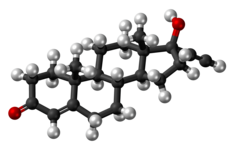 | |
 | |
| Clinical data | |
|---|---|
| Trade names | Proluton C, Pranone, others |
| Other names | Ethinyltestosterone; Ethynyltestosterone; Pregneninolone; Anhydrohydroxyprogesterone; Etisteron; Pregnin; Ethindrone |
| Routes of administration | By mouth, sublingual[1] |
| Drug class | Progestogen; Progestin; Androgen; Anabolic steroid |
| ATC code | |
| Pharmacokinetic data | |
| Metabolites | • 5α-Dihydroethisterone[2] |
| Identifiers | |
| |
| CAS Number | |
| PubChem CID | |
| ChemSpider | |
| UNII | |
| ChEBI | |
| ChEMBL | |
| CompTox Dashboard (EPA) | |
| ECHA InfoCard | 100.006.452 |
| Chemical and physical data | |
| Formula | C21H28O2 |
| Molar mass | 312.453 g·mol−1 |
| 3D model (JSmol) | |
| |
| |
| (verify) | |
Ethisterone, also known as ethinyltestosterone, pregneninolone, and anhydrohydroxyprogesterone and formerly sold under the brand names Proluton C and Pranone among others, is a progestin medication which was used in the treatment of gynecological disorders but is now no longer available.[3][4][5] It was used alone and was not formulated in combination with an estrogen.[1][6] The medication is taken by mouth.[4]
Side effects of ethisterone include masculinization among others.[4][7][8] Ethisterone is a progestin, or a synthetic progestogen, and hence is an agonist of the progesterone receptor, the biological target of progestogens like progesterone.[9] It has some androgenic and anabolic activity and no other important hormonal activity.[9][10][11][12][13]
Ethisterone was discovered in 1938 and was introduced for medical use in Germany in 1939 and in the United States in 1945.[14][15][16] It was the second progestogen to be marketed, following injected progesterone in 1934, and was both the first orally active progestogen and the first progestin to be introduced.[17][18][15] Ethisterone was followed by the improved and much more widely used and known progestin norethisterone in 1957.[19][20]
- ^ a b Cite error: The named reference
UCPress1952was invoked but never defined (see the help page). - ^ Cite error: The named reference
pmid9182866was invoked but never defined (see the help page). - ^ Swyer GI (March 1950). "Oral Hormonal Therapy for Menstrual Disorders". British Medical Journal. 1 (4654): 626–634. doi:10.1136/bmj.1.4654.626. PMC 2037145. PMID 20787798.
- ^ a b c Morton IK, Hall JM (31 October 1999). Concise Dictionary of Pharmacological Agents: Properties and Synonyms. Springer Science & Business Media. pp. 115–. ISBN 978-0-7514-0499-9.
- ^ "Ethisterone". Drugs.com. Archived from the original on 2019-06-24. Retrieved 2018-02-04.
- ^ Cite error: The named reference
Krug1963was invoked but never defined (see the help page). - ^ Becker KL (2001). Principles and Practice of Endocrinology and Metabolism. Lippincott Williams & Wilkins. pp. 872–. ISBN 978-0-7817-1750-2.
- ^ Cite error: The named reference
WilkinsJones1958was invoked but never defined (see the help page). - ^ a b Cite error: The named reference
pmid18395441was invoked but never defined (see the help page). - ^ Cite error: The named reference
Bentley1980was invoked but never defined (see the help page). - ^ Cite error: The named reference
EglenJuchau2012was invoked but never defined (see the help page). - ^ Cite error: The named reference
pmid13942007was invoked but never defined (see the help page). - ^ Cite error: The named reference
pmid13922599was invoked but never defined (see the help page). - ^ Cite error: The named reference
FritzSperoff2012was invoked but never defined (see the help page). - ^ a b Lauritzen C, Studd JW (22 June 2005). Current Management of the Menopause. CRC Press. p. 45. ISBN 978-0-203-48612-2.
Ethisterone, the first orally effective progestagen, was synthesized by Inhoffen and Hohlweg in 1938. Norethisterone, a progestogen still used worldwide, was synthesized by Djerassi in 1951. But this progestogen was not used immediately and in 1953 Colton discovered norethynodrel, used by Pincus in the first oral contraceptive. Numerous other progestogens were subsequently synthesized, e.g., lynestrenol and ethynodiol diacetate, which were, in fact, prhormones converted in vivo to norethisterone. All these progestogens were also able to induce androgenic effects when high doses were used. More potent progestogens were synthesized in the 1960s, e.g. norgestrel, norgestrienone. These progestogens were also more androgenic.
- ^ Cite error: The named reference
Roth2014was invoked but never defined (see the help page). - ^ Twombly GH (1947). Endocrinology of Neoplastic Diseases: A Symposium by Eighteen Authors. Oxford University Press. p. 7.
- ^ William Andrew Publishing (22 October 2013). Pharmaceutical Manufacturing Encyclopedia, 3rd Edition. Elsevier. pp. 1504–1505. ISBN 978-0-8155-1856-3.
- ^ Bardin CW (22 October 2013). Recent Progress in Hormone Research - Volume 50: Proceedings of the 1993 Laurentian Hormone Conference. Elsevier Science. pp. 2–. ISBN 978-1-4832-8903-8.
- ^ Marks L (2010). Sexual Chemistry: A History of the Contraceptive Pill. Yale University Press. pp. 74–. ISBN 978-0-300-16791-7.
